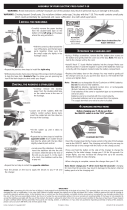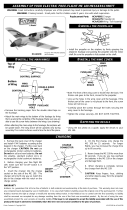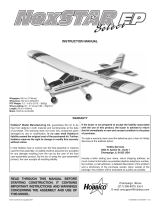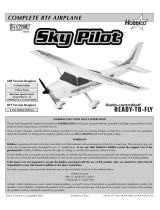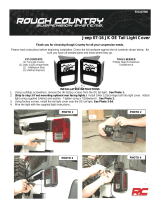Page is loading ...

ASSEMBLE ONLY WITH ADULT SUPERVISION
Please read through this instruction booklet to THOROUGHLY familiarize yourself with the assembly and
flight characteristics of this airplane before beginning to assemble this model.
Please inspect all parts carefully before starting assembly! If any parts are missing, broken or defective, or
if you have any questions about the assembly or flying of this airplane, please call us at (217) 398-8970 and
we’ll be glad to help.
WARRANTY
Hobbico
®
, Inc. guarantees this kit to be free from defects in both material and workmanship at the date
of purchase. This warranty does not cover any component parts damaged by use or modification. In no case
shall Hobbico’s liability exceed the original cost of the purchased model. Further, Hobbico reserves the right to
change or modify this warranty without notice.
In that Hobbico has no control over the final assembly, no liability shall be assumed nor accepted for any
damage resulting from the use by the user of the final user-assembled product. By the act of using the user-
assembled product, the user accepts all resulting liability.
If the buyers are not prepared to accept the liability associated with the use of this product, they are
advised to return this kit immediately in new and unused condition to the place of purchase.
C
C
OMPLETE R
OMPLETE R
TF
TF
AIRPLANE
AIRPLANE
Requires 8 “AA” and 6 “D”
Alkaline Batteries (not included)
Quiet Electric Flight
Radio-Controlled Model
Entire Contents © Copyright 2003 Printed in China HCAZ3061 for HCAA2014 V1.0
™
™

Your SKY SCREAMER
™
is not a toy, but rather a
sophisticated, working model that functions very much
like an actual airplane. Because of its realistic
performance, the model, if not assembled and operated
correctly, could possibly cause injury to yourself and
spectators or damage property.
We highly recommend that you get experienced,
knowledgeable help with assembly and during your
first flights, to make your R/C modeling experience
totally enjoyable. You’ll learn faster and avoid risking
your model before you’re truly ready to solo. Your local
hobby shop has information about flying clubs in your
area whose membership includes qualified instructors.
You can also contact the national Academy of Model
Aeronautics (AMA), which has more than 2,500
chartered clubs across the country. Instructor training
programs and insured newcomer training are available
through any one of these clubs.
Contact the AMA at the address or toll-free phone
number below.
Academy of Model Aeronautics
5151 East Memorial Drive
Muncie, IN 47302
(800) 435-9262
Fax: (765) 741-0057
or via the internet at: http://www.modelaircraft.org
1. Assemble the plane according to the instructions. Do
not alter or modify the model. If you make any
modifications, you will void your warranty.
2. Test the operation of the model before each flight to
insure that all equipment is operating properly, and that
the model remains structurally sound.
3. Fly only on calm days (with wind speeds less than 5
mph) and in large open areas free of trees, people,
buildings or any other obstacles.
Remember: Take your time and follow the instructions
to end up with a well-built model that is straight,
durable and easy to fly.
The R/C model hobby becomes more and more
enjoyable as your experience grows. Your chances for
success and graduation to higher levels are very good if
you take your time and follow the assembly and flying
instructions carefully and completely. We hope you
enjoy flying your SKY SCREAMER.
Electronic Control Unit: This unit controls the motors.
Also, it monitors the battery voltage and turns off the
motors when the voltage gets low. That way there will
be enough battery power to only operate the motors for
steering during the landing.
Motors: The motors rotate the props to provide thrust.
NiMH Battery: Rechargeable batteries which are used
to power the airplane.
Transmitter (TX): This is the hand-held unit that sends
the signal to the receiver. As you move the sticks on the
transmitter, the motors in the airplane will react
accordingly.
GLOSSARY
PRECAUTIONS
PROTECT YOUR MODEL, YOURSELF
AND OTHERS.
FOLLOW THIS IMPORTANT SAFETY
PRECAUTION
2

3
AIRFRAME PARTS AND HARDWARE
1
2
3
4
5
6
7
8
9
11
12
10
UNPACKING THE BOX
Check the parts against the list below. If any
parts are damaged or missing, give us a call
at: (217) 398-8970.
Part Name Qty.
❏1. Transmitter Antenna.............1
❏2. Transmitter...........................1
❏3. Fuselage ..............................1
❏4. Charger................................1
❏5. Wing ...................................1
❏6. Horizontal Stabilizer............1
❏7. Landing Gear.......................1
❏8. NiMH Battery ......................1
❏9. Fin .......................................1
❏10. Screwdriver .........................1
❏11. Propellers ............................4
❏12. Wrench ...............................1
ITEMS NOT SHOWN
Part Name Qty.
❏ Spare Wing..........................1
❏ Spare Tail Set .......................1
❏ Instruction Manual ..............1
❏ Instruction Video .................1

Welcome to the world of R/C Aero modeling. You will
find your new hobby to be exciting, very interesting,
and most of all, a lot of fun. You have purchased, quite
possibly, the best flying, the most reliable, and the
easiest flying R/C airplane available today. Be sure to
follow the written instructions and the video
instructions completely and in detail, doing this will
assure you a successful first flight and many continued
hours of enjoyment from your new R/C hobby.
❏1. Locate the fin, the fuselage, the horizontal
stabilizer
and the wrench.
❏2. Remove the small nuts and washers already placed on
the
threaded shafts located on the bottom of the fin.
❏3. Carefully place the threaded shafts
through the holes
in the horizontal stabilizer as shown in the photo above.
Note: Make sure the fin is placed through the horizontal
stabilizer with the decals up as shown above.
❏ 4. Insert the horizontal stabilizer/fin combination
through the holes in the tail boom as shown in the
above photo. Make sure you place the fin on the top of
the horizontal stabilizer by checking that the decals are
on the top side of the horizontal stabilizer. It is also
important to make sure that the fin fits completely flat
against the horizontal stabilizer.
❏ 5. Replace the nuts and washers onto the threaded
shafts that extend below the tail boom using the wrench
supplied with the model. Do not overtighten these nuts;
this could damage both the horizontal stabilizer and the
INSTALL THE HORIZONTAL
STABILIZER & FIN
ASSEMBLY INSTRUCTIONS
4

fin. Tighten them only until they are snug and will
remain in place.
❏ 1. Turn the fuselage upside-down and remove the
small Phillips screw from the landing gear plate using
the screwdriver included with the airplane.
❏ 2. Remove the landing gear plate from the fuselage.
❏ 3. Slide the landing gear wire into the the landing
gear slot as shown above. Install the landing gear plate
over the landing gear.
❏4. Secure the assembly with the small Phillips screw.
❏ 1. Remove the two wing mounting screws from the
top of the fuselage. These screws are indicated in the
above photograph.
❏ 2. Carefully slide the wing into position as shown
under the motor covers. It is not necessary to remove or
loosen these covers.
INSTALL THE MAIN WING
INSTALL THE LANDING GEAR
5

❏ 3. Secure the two wing mounting screws into the
wing as shown in the above photograph. Do not
overtighten them.
❏ 1. Press the propellers onto the motors. To prevent
the props from binding, be sure to leave a small space
(about the same thickness of a penny), between the
propellers and the back of the motor covers.
• Caution: Do not use rechargeable (NiCd) batteries.
• Do not mix old and new batteries.
• Do not mix alkaline, standard (carbon-zinc) or
rechargeable (NiCd) batteries.
❏ 1. Place the transmitter antenna into the top of the
transmitter case as shown above. Tighten it down
“clockwise” until it has a snug fit. Do not overtighten
the antenna.
❏2. The transmitter that controls your airplane requires
eight alkaline “AA” batteries. To install the batteries, turn
over the transmitter, remove the battery hatch and install
the batteries following the diagram inside the battery
compartment.
❏ 3. Reinstall the battery hatch, switch on the
transmitter and check the LED’s on the front of the
transmitter. If both the red and green lights are on, it is
safe to fly. If only the red light is on, you need to install
fresh batteries. If no lights come on check to make sure
that the batteries are installed correctly.
INSTALL THE TRANSMITTER BATTERIES
INSTALL THE PROPELLERS
6

NOTE: DO NOT CHARGE THIS BATTERY UNLESS IT
HAS BEEN FULLY DISCHARGED.
❏1. Before operating your Sky Screamer you will need
to charge the NiMH battery pack. Remove the battery
cover from the provided charger and install six new “D”
size alkaline batteries as shown on the diagram inside.
❏ 2. Remove the battery pack from the box. Plug the
battery pack into the charger connector. Be careful – the
battery pack will plug in only one way.
❏3. Rotate the timer knob on the charger to 20
minutes.
Make sure the red light comes on after turning the knob
as this indicates that your battery is being charged.
❏4. After the battery pack is charged. Insert the battery
pack inside the fuselage by removing the canopy. Place
the battery inside the fuselage as shown above.
❏ 5. Do not plug the battery pack into the connector
inside the fuselage. Reinstall the canopy.
Important Note: The charging times will increase
with repeated charging. It is necessary to check the
temperature of your battery during charging as it will
be fully charged when the battery becomes warm to
the touch. Should it become Hot to the touch,
disconnect it IMMEDIATELY.
NEVER allow your battery pack to become hot and
never leave your charger unattended while charging
the battery.
CHARGE THE MOTOR BATTERY
7

Note: Before attempting to operate or fly your Sky
Screamer, please make sure you fully understand its
operation outlined in this section.
❏ 1. Make sure the battery is fully discharged before
charging.
❏ 2. Never leave a charging battery unattended.
❏3 Never let the battery charge until it feels hot. A hot
battery is an overcharged battery. Only let the battery
get warm to the touch.
❏ 4. If you ever use a different battery charger, charge
this battery pack only at a maximum charge rate of 0.6
amp. A higher charge rate will charge the battery pack
too quickly and heat up the wires.
❏ 5. A properly cared for battery pack will last a long
time. If the battery pack is continually overcharged or
charged at too high of a rate, the life of the battery pack
will be shortened.
❏6. After each flight, remove the battery pack from the
airplane and allow it to cool completely before
recharging.
ATTENTION: The product you have purchased is
powered by a rechargeable battery. At the end of its
useful life, under various state and local laws, it may be
illegal to dispose of this battery into the municipal waste
system. Check with your local solid waste officials for
details in your area for recycling options or proper
disposal.
This product contains a chemical known to the State of
California to cause cancer and birth defects or other
reproductive harm.
Note: The following is a detailed description of how
you will control your Sky Screamer in flight. Please
study it carefully so you will become familiar with the
operation of the transmitter when you head for the
flying site.
Your transmitter controls the height of the airplane by
operating both motors and the direction of the plane by
slowing down either the left or right motor.
❏ 1. First switch on the transmitter and make sure the
green and red lights are on.
❏ 2. Open the canopy on the fuselage and plug the
freshly charged battery pack into the plug in the
fuselage. The plugs will only go together in the correct
direction. Reinstall the canopy.
HOW DOES THE SKY SCREAMER WORK?
BATTERY RECYCLING
SAFETY PRECAUTIONS FOR
CHARGING BATTERIES
BEFORE GOING TO THE FIELD
8

❏ 3. Move the switch located on the left side of the
fuselage aft (rear) to the on position.
CAUTION: Stay clear of the propellers once the battery
pack is plugged in and the switch turned on.
❏4. Have an assistant launch the SKY SCREAMER after
you move the left stick on the transmitter forward (or
away from you). Both motors will run at full power. At
this setting the plane should climb at a 20° angle.
Release the left stick and both motors will stop.
❏ 5. Moving the right stick to the right will cause the
right motor to slow down.
This will cause the plane to turn
to the right
.
❏6. Moving the right stick to the left will cause the left
motor to slow down. This will cause the plane to turn to
the left.
❏ 7. Releasing the left stick your airplane will slowly
descend for landing. Fly down wind, passed your
landing spot and turn back into the wind. Release the
left stick and the airplane will glide in for a landing.
❏ 1. It is best to fly on calm days, at least for your first
few
flights, when there is little or no wind (5 mph
maximum). Also, find an area clear of trees, power lines
and other structures. Your flying location should be
about the size of a baseball diamond. A flying field for
R/C planes is best. Don't fly around groups of people,
especially children or within 6 miles of existing R/C
flying fields.
PREPARE FOR FIRST FLIGHT
AT THE FIELD
9

❏ 2. Make sure the battery pack is fully charged and
that the transmitter has fresh “AA” batteries installed.
❏3. If others are flying in the same area, make sure that
they are not using the same channel radio system you
are. The front of your transmitter has a tag with a
number on it. This is the channel frequency you are
using. If someone is on the same frequency, DO NOT
switch on your transmitter until they are done flying.
❏
1. Caution: Always launch the airplane away from
people and obstacles. It is important to adjust or "trim,"
your airplane before each flight. Select an open area to
test your plane.
❏2. With the motor off, grasp the airplane fuselage and
gently toss the airplane into the wind. It should glide
straight ahead and settle gently to the ground. See the
diagram below. If your plane dives (A) or stalls (B)
follow the steps included below until you have a correct
path (C).
A = Dive.
B = Stall and crash.
C = Correct flight path.
Note: If your airplane flies flat and level the first time,
DO NOT make any further adjustments!
❏3. If your airplane does not glide on path (C), using a
hobby knife, carefully cut along the sides of the elevator
and top and bottom of the rudders. Repeat step 2 until
proper flight is achieved.
If you have an airplane that follows either path (A) or
(B), cut
the sides of BOTH elevators as shown in the photo
above.
If your airplane follows path (A), bend both elevator tabs
up equally.
If your airplane follows path (B), bend both elevators
down equally.
D = Airplane turns left.
E = Airplane turns right.
RUDDER TRIMMING
ELEVATOR TRIMMING
10

If your airplane turns to the right (E) during glide tests,
cut the rudder top and bottom and bend the rudder to
the left.
If your airplane turns to the left (D) during glide tests, cut
the rudder top and bottom and bend the rudder to
the right.
❏ 1. Range check your radio before each flight. Switch
on the transmitter and plug the battery pack into the SKY
SCREAMER. Have a helper hold the airplane. With the
antenna collapsed, walk 50 feet away from the airplane.
Move both control sticks, checking that the motors run
and turn off following the control stick movement. If you
still have control over the airplane, it is safe to extend
the antenna and fly the airplane. If you do not have
control of the plane, make sure the batteries in the
transmitter are fresh and the battery in the plane is
charged. Also, make sure the wire antenna is extending
out the back of the plane. Do not cut the antenna wire
on the plane.
If you have never flown an R/C airplane before, we
recommend that you get help from an experienced R/C
pilot. Most R/C clubs have training programs that will
help you learn to fly quickly. If you cannot find an
experienced pilot to help you learn, the following will
help you get your airplane into the air.
1. First, turn your transmitter power switch “ON.” This
immediately puts you in control. Be sure to extend your
antenna completely.
2. Plug the freshly charged battery pack into the plug in
the fuselage. Reinstall the canopy and move the switch
to the on position. Caution: Stay clear of the propellers.
3. Have an assistant help with the launch. Move the
throttle stick forward so that both motors are
running.
Have your assistant launch the plane into the wind.
4. Allow the airplane to climb at a 20° angle for a few
seconds before turning it. This will allow the plane to
gain altitude and air speed.
5. To turn the SKY SCREAMER, move the right stick, left
or right until the plane has turned. When the SKY
SCREAMER is moving away from you, moving the right
stick to the left will make your plane turn to the left.
Moving the right stick to the right will make the plane
turn to the right.
6. When the plane is coming toward you, moving the
right stick left still causes the plane to turn left, but it
appears to turn to your right. In short, you have to
reverse the way you control the right stick. A good way
to familiarize yourself with the controls is when the
plane is coming toward you, turn your body so that you
are facing the same direction the plane is going, looking
over your shoulder at the plane. Now when you move
the right stick left the plane will go to your left.
7. Don’t let the airplane get too far away from you. The
farther away it is, the harder it is to see what the plane
is doing.
8. When learning to fly, it is best to keep the plane high
so that if you make a mistake, you have enough altitude
to correct the mistake.
It’s a known fact among fellow R/C pilots that your
airplane will land. It is up to you as to where and how
it lands.
1. The SKY SCREAMER will get approximately 5 to 7
minutes of flight, at full throttle, on a fully charged
battery before the motors stop. For your first couple of
flights we recommend that you attempt to land before
the motors stop. This will allow enough power to abort
the landing and try again if you miss your landing area.
LANDINGFLYING THE SKY SCREAMER
RANGE CHECK
11

2. During your first flight, while at a high altitude, turn
the motors off and notice how the SKY SCREAMER
reacts. This will give you an idea how the plane will
react during landing.
3. To land the SKY SCREAMER, fly down wind, past the
landing area, a few hundred feet. Gently turn into the
wind and turn the motors off. The plane will start to
come down. If it appears that the SKY SCREAMER will
be short of the landing area, turn the motors back on for
a couple of seconds to lengthen your approach. To do
this push the left stick forward.
4. As the SKY SCREAMER slowly descends, use the right
stick to control the direction. The SKY SCREAMER will
just about land itself. All you need to do is control its
direction by moving the right stick from side to side.
Move the switch on the side of the fuselage to the “OFF”
position then unplug the battery from the plane and
remove it from the battery compartment. Then, switch
the transmitter off. Allow the motor battery to cool
before recharging. Check the plane over to make sure
nothing has come loose.
Even the best R/C pilots in the world damage their
planes every now and then. In the unfortunate event
that you damage your airplane, repairs are fairly simple
to make yourself. If there are any cracks in the wing or
fuselage, apply 6-minute epoxy or white glue to the
broken area and hold together with clear packaging
tape. Let the glue cure, leaving the tape in place for
added strength.
Replacement parts for your SKY SCREAMER.
To order replacement parts for your SKY SCREAMER,
use the order numbers in the list below. Replacement
parts are available only as listed. Replacement parts are
not available from Product Support, but can be
purchased from hobby shops or mail order/Internet
order firms. If you need assistance locating a dealer to
purchase parts, contact:
Product Support
Phone: 217-398-8970
Fax: 217-398-7721
E-mail: [email protected]
Before starting to build, take an inventory of this kit to
make sure it is complete, and inspect the parts to make
sure they are of acceptable quality. If any parts are
missing or are not of acceptable quality, or if you need
assistance with assembly, contact Product Support.
When reporting defective or missing parts, use the part
names exactly as they are written in the parts list.
Stock Number Description
HCAA3483 Tail Set
HCAA3480 Main Wing Set
HCAA3489 Fuselage
HCAA3486 Motor Covers (2)
HCAA3485 Canopy
HCAG3476 Motors (2)
HCAM7111 NiMH Battery
HCAQ3480 Propeller
HCAQ3481 Landing Gear
HCAP9910 Field Charger
Cut out and tape to back of transmitter.
BEFORE FLIGHT CHECK LIST
1. Check the area to make sure no one is on your frequency.
2. Charge the airplane battery.
3. Switch on the transmitter and extend the antenna. Make sure
the red and green lights are on.
4. Remove the canopy and plug in the airplane battery.
5. Install the canopy.
6. Move the switch on the airplane to the “ON” position.
7. With an assistant, range check the radio system.
8. Move the left stick forward and launch the airplane.
AFTER LANDING
1. Switch off the airplane.
2. Switch off the transmitter.
3. Check over the airplane making sure nothing came loose.
PARTS LIST
REPAIRS
AFTER THE FLIGHT
/



